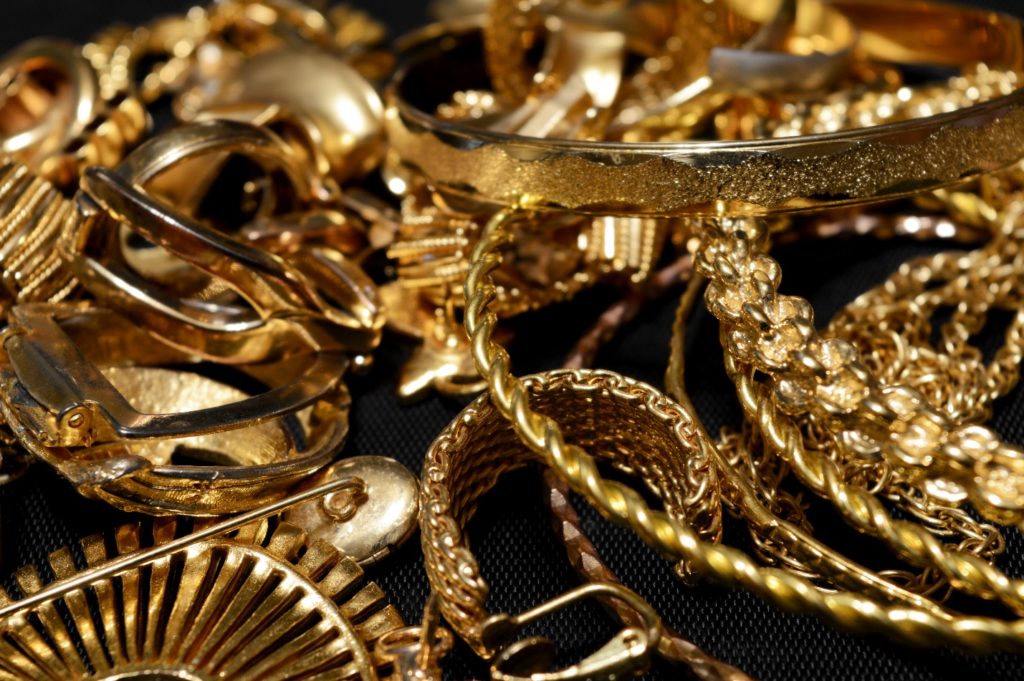At Cash for Gold USA, we provide a convenient, risk-free way to sell your gold, gold necklaces, gold bracelets, unwanted gold, and other gold jewelry and materials. Request you free Appraisal Kit now:
With your Appraisal Kit, you will receive a free, insured mailer so that you can ship your gold, silver, and diamond valuables to us to get our highest and best offer (guaranteed!).
Whether you have jewelry you no longer wear, assets you’re looking to liquidate, or you inherited some pieces you likely won’t use, Cash for Gold USA provides a convenient, risk-free process to sell your gold for cash.
How to Prepare Your Gold to Sell
Genuine gold is what gold buyers look for. It can be frustrating when you are trying to sell what you think is valuable gold only to discover it has no worth to a gold buyer. So, what can you do to avoid this? Here’s how to check if you have real gold to sell:
1. Check for Markings
Look for a karat marking to make sure it is gold and not gold-plated or gold-filled.
Rub your gold against a piece of unglazed porcelain. If it leaves a black streak it’s likely “fool’s gold” (pyrite) rather than real gold. A gold-colored streak is what you are looking for.
Gold is not magnetic, so hold a magnet above the gold item. If your item is attracted to the magnet, it’s not likely to have a very high karat value or be gold at all.
(Even commercial home testing solutions are only rough field tests and cannot tell you the exact composition of your gold items. The only way you can be certain of an item’s purity and value is to have it assessed by a professional with access to proper equipment.)
2. Get a Free Appraisal Kit
If you have gold to sell, request your free Appraisal Kit to see how much you can get when you sell your gold:
Once you fill out the form, we will send you a free, insured mailer so that you can send your items to us. Our GIA certified appraisers will assess your items, and within 24 hours we will make you an offer based on the current spot price of gold. Accept the offer and get paid, else we’ll ship your items back to you free of charge and insured. Our appraisers are equipped with Thermo-Fisher XRF Analyzers, high-tech gear that detects the purity and quality of your gold and precious metals with certainty.
Best of all, the metal analysis is non-invasive and non-destructive, so it will not damage your valuables, including antiques and heirlooms.
Cash for Gold USA’s high-tech equipment is good news for you when you choose to sell your gold to us because you can feel confident you will get a fair and accurate offer for your items.
3. Compare Offers
Evaluate multiple offers from gold buyers like jewelry stores, pawnshops, and online gold buyers (like Cash for Gold USA) before you decide where to sell. Compare offers, payment methods, and reputation.
Because of our low overhead, we actually guarantee you get the best offer.
What We Buy: Gold Other Items You Can Sell
The gold items we buy at Cash for Gold USA include, but are not limited to:
| Gold jewelry | Gold rings |
| Gold charms | Gold bracelets |
| Gold bangles | Gold watches |
| Gold necklaces | Gold chains |
| Broken jewelry | Rolled gold |
| Scrap gold | Gold coins |
| Silver jewelry | Silver coins |
| Silverware | Diamond jewelry |
Reasons You Might Want to Sell Gold Now
Right now, gold prices have been hovering near historic heights. Whether you have previously invested in gold bullion or are looking to make some extra cash by selling unwanted gold jewelry or other items, this is the perfect time to sell for a high amount. The following are just a few of the reasons it’s a good time to sell:
- Relatively low inflation: Even though higher inflation typically leads to higher gold prices, it’s also important to compare the rate of inflation to the rate at which the gold price is increasing.
- High prices: One of the primary rules of commodities trading is to buy low and sell high. In the case of gold, the current market price is close to its highest point on the gold chart in a century! It doesn’t get much better than that, making this a perfect time to get lots of cash for your gold.
- Uncertain economy: Because gold is an investment commodity, gold value increases as the economy’s stability weakens. The current uncertainty bodes very well for anyone looking to sell.
- Investor enthusiasm: Because the economy is so unstable, people are rushing to move their money into traditional investments like gold. When things began to decline in 2020, sellers found themselves quickly selling out of gold coins and bullion. This intense enthusiasm on the part of investors means great demand and great prices for gold sales.
- Immediate funds: Whether you’re experiencing financial difficulties or simply need additional cash right away, selling your gold can provide an immediate influx of funds. This is especially helpful right now, when many Americans are facing their own uncertainty with regard to income and assets.
Why Sell to Cash for Gold USA?
Cash for Gold USA buys a variety of items, including rings, charms, broken gold jewelry, watches, bracelets, necklaces, gold coins, and more. We buy white gold and yellow gold, and we will always give you a fair price.
Cash for Gold USA is an online buyer that stands out as a safe and reliable option for those looking to sell their precious items. Here is why:
- Cash for Gold USA has a reputation for trustworthiness. The company has been in operation for more than fifteen years and has earned an A+ rating from the Better Business Bureau. This rating is a testament to our company’s commitment to transparency and fair business practices.
- Cash for Gold USA’s process provides customers with a secure and convenient way to sell gold that sets it apart from other online buyers.
- We offer a free, insured shipping label that can be printed from our website, allowing customers to safely and easily send their items to the company at no cost to them, making it more convenient than working with those “buy gold near me” places. Once the items are received, the company’s experts appraise them and provide an offer within 24 hours. Customers can then choose to accept the offer or have their items returned to them free of charge.
- Cash for Gold USA also offers a Price “Beat” Guarantee: We will beat any competitor’s written offer or return your items to you free of charge.
- Cash for Gold USA is a safe choice for selling precious metals and diamonds online because of our commitment to customer privacy. We use the latest encryption technology to ensure all customer information, including the details of their transactions, is kept secure and confidential. We do not sell customer information to third-party companies, ensuring that customers are not bombarded with unwanted marketing materials.
Cash for Gold USA is a safe and reliable option for those looking to sell their unwanted or unused gold, silver, or diamonds online. With our reputation for transparency and fair business practices, commitment to customer privacy, and dedication to environmental sustainability, customers can trust they are getting the best possible price for their items while also making a positive impact on the world.
If you’re ready and still wondering how to sell gold online, you won’t find a more seamless process than what we provide at Cash for Gold USA. Get your free Appraisal Kit and sell your gold for cash from the comfort of your home:
FAQs About Selling Gold
What is the best way to sell gold?
The best way to sell gold depends on your priorities. If you absolutely need money right now, then you might want to go to a local jeweler, pawn shop, or a We Buy Gold shop. However, we think selling gold online to Cash for Gold USA is the best way to sell gold, based on the information above.
How much will I get if I sell my gold?
Here is how much you will get if you sell your gold to Cash for Gold USA: After determining the weight and purity of your gold, we’ll look at the current spot price of gold in the United States on the day we do your evaluation and make you a fair market offer. Our payments are calculated based on pennyweights, which is standard in the precious metals industry worldwide.
How much is my gold worth?
Gold’s weight and karat value are factors in determining its worth. To start selling gold online with Cash for Gold USA, simply determine your gold’s weight and karat value. The purity of gold is known as “karat,” and most items fall under the following karat values:
- 24k: 99% purity
- 22k: 91.7% purity
- 18k: 75% purity
- 14k: 58.33% pure gold
- 10k: 41.67% pure
- 8k: 33.37% pure
Our offers are based on the purity (karat) and weight of the precious metal and the spot price of the precious metal on the day we evaluate your gold.
What is the best place to sell gold?
You have some options when you want to sell gold jewelry. You can sell your gold to a local gold buyer, a local jeweler, a pawn shop, or an online buyer like Cash for Gold USA. We like to think we are the best place to sell gold jewelry, gold, silver, platinum, and other precious metals. You can find out for yourself when you request a free Appraisal Kit, ship your materials to us for free, and receive a fair market offer within 24 hours.
How do you sell gold for what it’s worth?
To get the best price for your gold, know the value, get appraisals, and consider the timing. Do some research to find the best place to sell your gold. You can do a search for “sell gold near me” to see where you can sell gold for cash. However, a pawn shop, jeweler, or local gold buyer might not make you the best offer.
At Cash for Gold USA, we offer a Price “Beat” Guarantee: We will beat any competitor’s written offer or return your items to you free of charge.
Is it worth it to sell gold now?
Whether it’s worth it to sell gold now depends on the current market price of gold, your personal financial situation, and your reason for selling.
About Cash For Gold USA
Cash for Gold USA is a prominent online buyer of gold, silver, platinum, and palladium in the United States. Since 2005, we have paid millions to thousands of customers for their unwanted or broken precious metal jewelry. We offer a quick and straightforward selling process, ensuring customers receive prompt and competitive offers for their items. Learn more about us and what our customers say about Cash for Gold USA, or request your free Appraisal Kit now:



